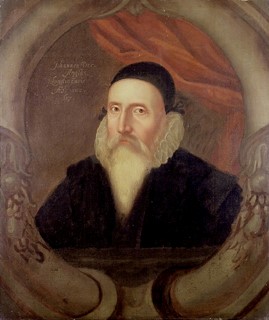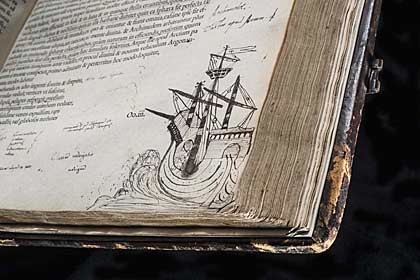London, Royal College of Physicians.
‘Scholar, courtier, magician: The Lost Library of John Dee’
I’ve been researching Dee for nearly 4 years now, from MA to PhD, so it was not without some trepidation that I read the announcement of an exhibition of his life and books. What if this led me down an entirely different path in my research, so near to finishing? What if he was presented as Meric Casaubon’s gullible madman, or a Crowley-esque conjurer, the very perceptions I’ve been trying so hard to dispel? Thankfully my fears were groundless! The Royal College of Physicians in London has found the perfect balance in Dee’s various reputations to launch an exhibition which The Times describes as ‘A revelatory show. As the visitor peers, he finds himself drawn ever more deeply not just into the historical world of the Tudors but into the labyrinthine mind of one of its most riveting denizens’.

John Dee is truly the man of the moment, thanks largely to the RCP Museum’s press officers and the extensive media coverage in the lead-up to the opening. Dee’s long and varied political and scholarly associations –and perhaps most importantly, his books – are finally being brought to the attention of a larger audience. The RCP holds the largest single collection of Dee’s extant manuscripts, more than 100 out of thousands now unfortunately lost to time. This exhibition marks the first time that a collection of his books have gone on display together. Alongside loan items from the British Museum and Science Museum (Dee’s ‘magical’ objects), the exhibition displays a portrait of Dee from the Ashmolean Museum, and the star of the gallery, Henri Gillard Glindoni’s extraordinary C19th painting of ‘John Dee performing an experiment before Elizabeth I’ from the Wellcome Collection. There has been a resurgence of interest in the x-ray imaging completed on the painting lately in the press. For more on the hidden layer of human skulls beneath the current painting see The Guardian‘s article here.

Dee was a voracious reader. He didn’t simply skim his books, but wrote copious notes that demonstrate how fully he interacted with the text. For me, one of the most satisfying aspects of reading Dee’s books is coming across his comments and drawings. The RCP’s exhibition explores this annotation style, bringing to light some of the wonderful ‘doodles’ in the margins of his books. Katie Birkwood, Rare Books and Special Collections librarian and the curator of the exhibition, has created some wonderful gif images of these doodles which you can find on the @RCPmuseum twitter feed. The exhibition playfully invites its guests to create their own ‘Dee doodles’ to be put on display within the section on marginalia. This interactive approach encourages its audience to participate at a more engaged level than simply looking at books in cases. Dee’s doodles demonstrate the creativity of a brilliant mind and may have been used as mnemonic devices to recall the text they accompany. One of the most intricate examples on display is a detailed drawing of a ship in the margins of Cicero’s Opera.

John Dee was a true polymath, writing on such diverse subjects as alchemy, navigation, genealogy, imperialism, mathematics, and natural philosophy. Yet, it is Dee’s reputation as a conjurer who conversed with angels which has gripped the popular imagination, enduring from his own lifetime to the present day. The RCP’s exhibition treats this aspect of Dee’s reputation with care, addressing the myths surrounding the more occult aspects of the magus’ life. Most pleasing was the accompanying blurb to the British Museum’s objects which pointed out that there is no direct provenance between the magical objects and Dee, we do not know if they are the instruments he actually used in his experiments, or reproductions based on his manuscript descriptions and illustrations. This little nugget of information is glaringly omitted from the British Museum’s own display cases!
As part of the exhibition, artist and filmmaker Jeremy Millar was commissioned for a short film entitled ‘A Constellation for John Dee’. The film is narrated by Jenny Runacre (who portrayed Elizabeth I alongside Richard O’Brien’s Dee in Derek Jarman’s 1978 film Jubilee). The film is a ‘meditative and evocative exploration of Dee’ which ties together image and voiceover to provide a narrative of Dee’s life and work. The film can be viewed in the designated space at the RCP, or online at YouTube.
Birkwood and her team have worked tirelessly to curate an exhibition that addresses many aspects of Dee’s life and reputation (no small feat!). The displays portray a man of great intellect, an avid reader and a creative ‘doodler’, whose socio-political engagements did not always pan out how he wished. A lack of sustained patronage and suspicions regarding his angelic conversations have cast Dee as an outsider of sorts, on the margins of society. However, Dee was well respected as a scholar in mathematics and philosophy and the Queen frequently favoured him with visits and gifts. The exhibition carries across the message that the various facets – scholar, courtier, and magician – which are explored here, are not mutually exclusive. Dee could be all these things, and more besides. The image of Dee as the Great Conjurer is not one which will be easily erased from the collective conscious, it is much too fascinating a myth for a culture with a love of the occult taboo, but this exhibition makes huge strides to re-present Dee as much more worthy of our attention for his scholarly engagement in multiple fields. One thing I noted from my conversations with other attendees is that Dee scholarship is not a ‘toe-treading’ area of expertise. It speaks to Dee’s wide range of interests that so many researchers can find him fascinating but for so many different reasons. His interdisciplinary appeal permits for an open and enthusiastic exchange of ideas and information that embodies, as I think of it, the kind of intellectual hub fostered at Dee’s own Mortlake library. In this way, we might see Dee as an ‘everyman’ for the academic, for surely if we find an interest in some obscure topic Dee would have found it first!
The exhibition runs until 29th July 2016 in the Royal College of Physicians, Regent’s Park, open from 9am-5pm on weekdays. Curator tours and other special events are planned, details of which can be found on the website here.
With special thanks to Katie and the RCP team for the invitation to the private opening of the exhibition, and her encouragement in my own research.